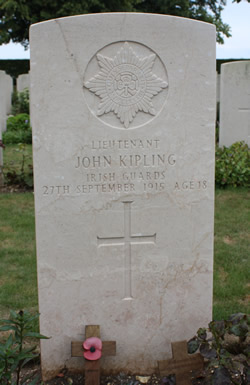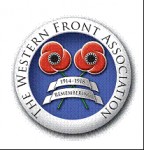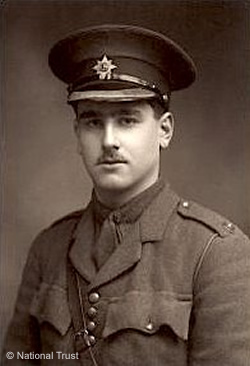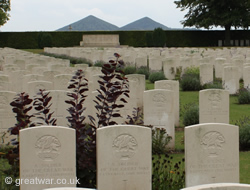The Unidentified Irish Guards Lieutenant at Loos

|
On 23 September 1919 the remains of a casualty were discovered by a British Army burial party searching the old Loos battlefield. The casualty was recorded as an “Unidentified British Soldier, Officer Lieut. Irish Guards”. (1) The casualty discovered in 1919 was exhumed on the same day as 56 other men from a search recorded by the burial party as grid square G.25 on British military map sheet 44a. These 57 men were all reburied north of Loos-en-Gohelle village at one of the three British military concentration cemeteries for the Loos battlefield. The cemetery they were taken to was then called St. Mary’s Cemetery and is now called St. Mary’s ADS Cemetery. The unidentified Irish Guards officer was buried in Plot 7, Row D, Grave 2. St. Mary's ADS Cemetery is located about 1.5 miles (2.4kms) north of Loos village and about 2,500 yards (2286m) north-west of Chalk Pit Wood. Chalk Pit Wood is the location where the 2nd Battalion Irish Guards was in action on 27 September 1915.
In 1992 the Commonwealth War Graves Commission replaced the headstone at the grave of the unidentified Irish Guards lieutenant with a stone bearing the name of Lieutenant John Kipling. The identity of the man in this grave has, since then, been the subject of debate:
- Location of the casualty: The map reference of G.25.c.6.8 (British military map sheet 44a/36c) for the discovered remains implies they were found near Mazingarbe, some 3 miles (5kms) behind the British front line of 1915-1918. Mazingarbe was 3 miles west of where John Kipling was wounded and missing in action with the Irish Guards.
- Missing Irish Guards officers: Three Irish Guards officers died on 27 September 1915. After the war all three of their burial locations were lost.
- Rank: The public announcement of John Kipling’s promotion to lieutenant was not published in The London Gazette until after his death. For this reason it is claimed that he would not have been in a position to have been wearing the rank of a lieutenant when he died. Also, he had lost his identity disc and his letter to his father on 19 September 1915 requested a replacement stating his rank as 2/Lieutenant. (2)
On 6 August 2015 the authors of this website, Lt. Col. (Retd) Graham Parker and his daughter Joanna Legg, presented new evidence to the Commonwealth War Graves Commission (CWGC) to prove that the typed map reference of G.25.c.6.8 on the Burial Return for this man was wrong. They confirmed that the reference of grid square G.25.c could not be correct and that the correct reference should have been recorded as H.25.c. Their research also confirmed that the battalions of the three identified casualties discovered at the same time as the Irish Guards lieutenant were in the front line location of grid square H.25 on the dates when they were killed in action in 1915, 1916 and 1917. The new evidence was welcomed by CWGC, confirming the corrected map reference as H.25 for the discovered Irish Guards lieutenant and all the men listed on the Burial Return at G.25.c. A media statement from CWGC in September 2015 confirmed that new evidence regarding the map reference of H.25 had been included in a review of all aspects of the John Kipling case.
Graham and Joanna's research focused on the following key points:
- Their Discovery that Grid Reference G.25.c was Incorrect: H.25 was the Correct Grid
Reference
An examination of the documented grid reference of G.25.c for the discovery of the unidentified Irish Guards lieutenant in September 1919 produced unequivocal evidence that the grid reference letter of “G” is incorrect. Graham had discovered that the sub-square of G.25.c does not exist on Map Sheet 44. This was confirmed by a historian specialising in the study of WW1 British military maps. This could not be the location of the discovery of the remains of any of the men recorded at G.25.c on this or any other Burial Return. Graham and Joanna provided War Diary evidence for the battalion locations at H.25 near Chalk Pit Wood for each of the three identified casualties discovered at the same time as the Irish Guards lieutenant: Pte P Blaber of 15th Bn London Regiment, Pte P McGee of 6th Bn Royal Irish Regiment and Pte T McPherson of 2nd Bn Eastern Ontario Regiment. Each battalion had been located in the British front line A Sector in square H.25 on the dates of the three identified men's deaths in action. In August 2015 Graham and Joanna provided their compelling evidence to CWGC that the correct grid reference for the Irish Guards lieutenant should have been recorded on the Burial Return of 23 September 1919 as “H.25.c.6.8”. - The Resurveyed Location of Chalk Pit Wood
Research into the resurveyed maps of the Loos battlefield showed that the discovered remains of the Irish Guards lieutenant at the corrected reference of H.25.c.6.8 were found at the left (west/north) edge of Chalk Pit Wood. This provided a crucial link to the Irish Guards officer's remains and a witness statement given in 1917 to Rudyard Kipling by Sergeant Farrell of the Irish Guards. Farrell told Rudyard Kipling that he had carried the seriously wounded John Kipling to the left edge of Chalk Pit Wood, had placed him in a shell hole there and left him as he believed him to be dead. - Lieutenant John Kipling on 27 September 1915
The public announcement of John Kipling's promotion to the rank of lieutenant appeared after his death in the Third Supplement to The London Gazette on 11 November 1915. The London Gazette provides the public announcement of the promotion. However, it is the Military Secretary's Branch, War Office, which is the authority providing the official notice of the promotion. The date of 7 June 1915 in The London Gazette announcement was the date of John Kipling's substantive promotion to lieutenant by the Military Secretary's Branch. (3) In addition, a document in his Officer's Service Record confirms John Kipling's pay at the rank of lieutenant (8/6d) for a period of 186 days. (This dates the lieutenant's pay back to 29 April 1915 and includes an overpayment of 34 days from 28 Sept-31 Oct 1915 after his death.) (4) On the date of the death of John Kipling, 27 September 1915, he was officially a lieutenant. Following the publication of the promotion in The London Gazette of 11 November 1915, Rudyard Kipling wrote a letter to his friend Colonel L C Dunsterville. In the letter he acknowledged that his son was officially a lieutenant at the time of the battle and his death, saying that John was at that rank at only 18 years and 6 weeks of age; John was in action 6 weeks after he had arrived in France on his 18th birthday. (5) Joanna discovered evidence that, unusually, a 1st Battalion Irish Guards officer was ordered to put up his rank in mid September 1915 before publication of the announcement in The London Gazette. This sets a precedent that John Kipling's commanding officer did receive the notice of his promotion before the battle and ordered John to put up the rank without waiting for it to appear in The London Gazette.
No other Irish Guards lieutenant was missing in the Loos battle sector on that date or at any time during the month while the Irish Guards were in the sector. The Irish Guards did not return to the Loos sector after 1915. Of the three Irish Guards officers who died on 27 September - Kipling, Clifford and Pakenham Law - the burial places of Clifford and Pakenham Law were known during the war. They were both Second Lieutenants. John Kipling was the only man of the three who was entitled to wear the rank of lieutenant on that date. 2/Lt Clifford was known to have been buried behind the German lines; the German Army had returned his identity disc. 2/Lt Pakenham Law was recorded in the Battalion War Diary as having been wounded while digging in on the south edge of Chalk Pit Wood, and that he died of a head wound “in hospital”. (6) The implication of this statement in the battalion War Diary is that that he was removed from the forward battle area at Chalk Pit Wood to be taken to a medical aid post. Law was officially recorded as being buried between Chalk Pit Wood and Lone Tree (Lone Tree was the location of a forward aid post on the day of the battle). (7)
The 23 September 1919 Burial Return stated that the discovered casualty was a lieutenant in the Irish Guards. The Burial Return was signed off by an experienced soldier and engineer of good reputation, 2/Lieutenant A Domaille, who had served as a sergeant for two years during the war with the 6th Bn Royal Irish Regiment. Unless evidence can be found to dispute the Burial Return record that the discovery was an “Irish Guards Officer Lieutenant”, the conclusion must be that John did go into the battle wearing the rank of lieutenant. Based on Graham and Joanna's findings for the corrected map reference at H.25.c and their corrected location of the remains being found at the edge of Chalk Pit Wood, they consider that, on the balance of probabilities, the remains of the Irish Guards lieutenant discovered by the September 1919 burial party must be Lieutenant John Kipling.
Following the media statement by CWGC in September 2015 an article was published in The Irish Times (25 September 2015) regarding the reappraisal of the John Kipling case. The article confirmed that the Commission was satisfied it had made the right call in 1992 due to “clear and compelling” evidence, and that the body of John Kipling had been found in the place where he had fought when he disappeared i.e. the location of H.25. On 28 October 2015 the CEF Study Group announced the discovery of a burial document (Circumstance of Death Register) confirming that the Canadian casualty, Pte McPherson, had been buried in the front line sector at H.25. This significant find supports Graham and Joanna's findings regarding the corrected map reference as H.25 for all three of the identified casualties killed in action and the Irish Guards lieutenant on the Burial Return of 23 September 1919.
Article in the WFA Stand To! (January 2016)

For information about an article by Graham and Joanna published in January 2016 in the Western Front Association journal Stand To! contact Tom Thorpe, National WFA PR and Media Officer.
Email: press@westernfrontassociation.com
Telephone: +44-7779 269 182
John Kipling Wounded and Missing in Action

|
On the afternoon of 27 September 1915 Lieutenant John Kipling went into action commanding 5 Platoon, 2 Company, 2nd Battalion Irish Guards. It was the third day of the British offensive in Artois, the Battle of Loos. From 4.00pm the four companies of 2/Irish Guards advanced from a position north of Loos village towards Chalk Pit Wood. John was wounded and subsequently was missing.
John was the only son of Rudyard Kipling, the famous journalist, Nobel Prize winner, poet and writer of short stories including Barrack-Room Ballads, The Jungle Books, Kim and the Just So Stories. John left Wellington College in April 1914 aged 16. He served as a private in the Officer Training Corps and was keen to join the army. Applying for a commission soon after the outbreak of war in August he was rejected due to his eyesight. A further application was nominated by Field Marshal Lord Roberts, the first Honorary Colonel of the Irish Guards from its formation in 1900 and a friend of Rudyard. John was passed medically fit, joining the Special Reserve on 19 August 1914. On 11 September Col. Douglas Proby, Officer Commanding the Irish Guards, recommended John’s application for a Commission to the Military Secretary, War Office. (8) After training John arrived in France with 2/Irish Guards in the early morning of 17 August 1915, his 18th birthday.
St. Mary's ADS Cemetery
The cemetery is located north of the village of Loos-en-Gohelle and is the location of the grave of Lieutenant John Kipling.
Related Links
The Commonwealth War Graves Commission
Website: www.cwgc.org
The Kipling Society
Website: www.kiplingsociety.co.uk
The Western Front Association (WFA)

Lt. Col. Graham Parker, OBE (Retd) is a Vice-President of the Western Front Association. Joanna Legg has been a member since 1987. For information about the WFA, how to join, resources for schools, articles, lectures, events, commemorations and much more, visit the WFA website:
Website: www.westernfrontassociation.com
Acknowledgements & Sources
(1) Burial Return, dated 23 September 1919, Hulluch 18/176E-177E and Hulluch 6/22-23E. Commonwealth War Graves Commssion.
(2) SxMs-38/3/2/1/1/1 Kipling Papers, Wimpole Archive. Letters from John Kipling 1915, The Keep, University of Sussex.
(3) The London Gazette, 9 November 1915, Third Supplement 11 November 1915, Supplement 29363, p. 11161.
(4) WO 339/53917 Officers’ Services, Long Service Papers Lt J Kipling, The National Archives, Kew
(5) Thomas Pinney, The Letters of Rudyard Kipling: 1911-19, Volume 4, (University of Iowa Press: 1990), p. 344.
(6) WO 95/1220/1 War Diary 2/Irish Guards, August – October 1915.
(7) WO 339/45127 Officers’ Services: Long Service Papers, 2/Lt Thomas Pakenham Law.
(8) The London Gazette, Issue 28902, 15 September 1914, p. 7303. The order of precedence of Second Lieutenants in the Irish Guards was restated for J Kipling as 15 August 1914 in The London Gazette, Issue 29070, dated 16 February 1915, p. 1565.
